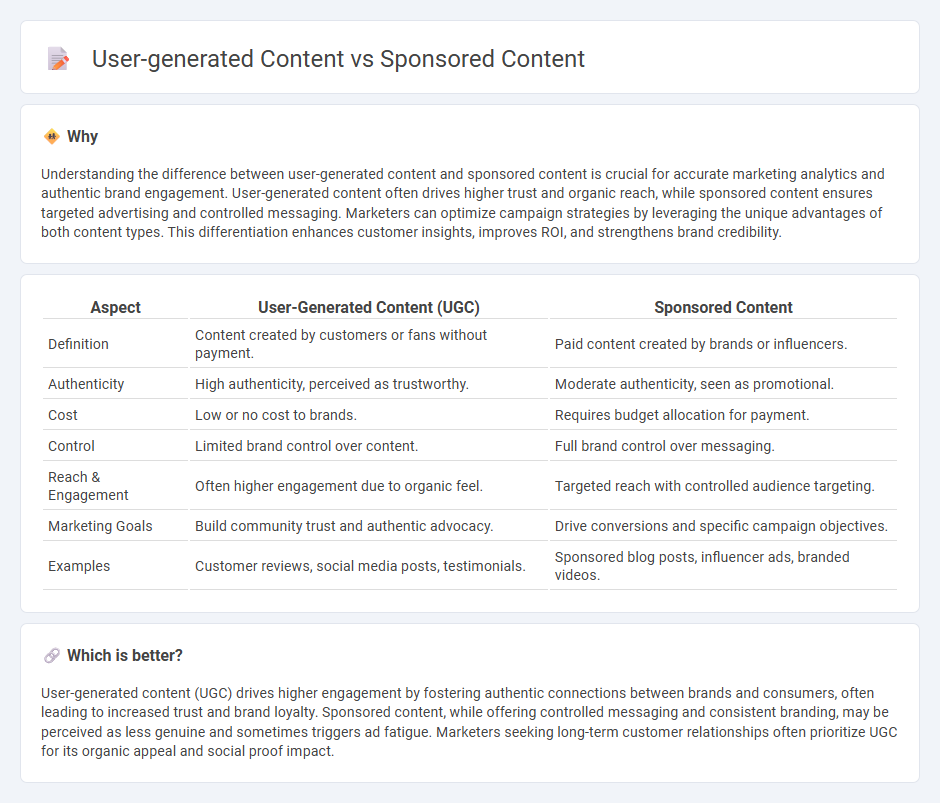
User-generated content (UGC) leverages authentic, customer-created material to build trust and engage audiences organically, often resulting in higher brand credibility and stronger community connections. Sponsored content, produced or paid for by brands, allows precise messaging control and targeted reach across platforms, enhancing visibility and strategic brand positioning. Explore deeper insights into how these content types can transform your marketing strategy effectively.
Why it is important
Understanding the difference between user-generated content and sponsored content is crucial for accurate marketing analytics and authentic brand engagement. User-generated content often drives higher trust and organic reach, while sponsored content ensures targeted advertising and controlled messaging. Marketers can optimize campaign strategies by leveraging the unique advantages of both content types. This differentiation enhances customer insights, improves ROI, and strengthens brand credibility.
Comparison Table
| Aspect | User-Generated Content (UGC) | Sponsored Content |
|---|---|---|
| Definition | Content created by customers or fans without payment. | Paid content created by brands or influencers. |
| Authenticity | High authenticity, perceived as trustworthy. | Moderate authenticity, seen as promotional. |
| Cost | Low or no cost to brands. | Requires budget allocation for payment. |
| Control | Limited brand control over content. | Full brand control over messaging. |
| Reach & Engagement | Often higher engagement due to organic feel. | Targeted reach with controlled audience targeting. |
| Marketing Goals | Build community trust and authentic advocacy. | Drive conversions and specific campaign objectives. |
| Examples | Customer reviews, social media posts, testimonials. | Sponsored blog posts, influencer ads, branded videos. |
Which is better?
User-generated content (UGC) drives higher engagement by fostering authentic connections between brands and consumers, often leading to increased trust and brand loyalty. Sponsored content, while offering controlled messaging and consistent branding, may be perceived as less genuine and sometimes triggers ad fatigue. Marketers seeking long-term customer relationships often prioritize UGC for its organic appeal and social proof impact.
Connection
User-generated content (UGC) and sponsored content intersect in marketing by leveraging authentic consumer experiences to enhance brand credibility while driving targeted promotions. Brands utilize UGC to create genuine engagement and then amplify these narratives through sponsored content to reach broader audiences efficiently. This synergy increases trust and conversion rates by combining peer influence with strategic advertising investment.
Key Terms
Authenticity
Sponsored content often prioritizes brand messaging and polished visuals, while user-generated content (UGC) thrives on genuine experiences and personal storytelling. Authenticity in UGC boosts consumer trust and engagement, making it a powerful marketing tool that resonates more deeply with audiences. Explore effective strategies to leverage both types for authentic brand promotion.
Credibility
Sponsored content often faces skepticism due to perceived commercial bias, while user-generated content (UGC) enhances credibility by offering authentic and relatable experiences from real users. Research shows that 92% of consumers trust UGC more than traditional advertising, making it a powerful tool for building brand trust. Explore effective strategies to leverage both types of content for maximizing credibility and audience engagement.
Control
Sponsored content allows brands to maintain full control over messaging, format, and distribution, ensuring alignment with marketing objectives and brand guidelines. User-generated content offers authentic engagement and diverse perspectives but limits brand control over the narrative and timing. Explore deeper insights into balancing control and authenticity to optimize content strategy.
Source and External Links
5 Excellent Examples of Sponsored Content Marketing - ClearVoice - Sponsored content includes paid promotional media such as sponsored articles, videos, and listicles designed to promote a brand while providing valuable content (e.g., BuzzFeed's Spotify-sponsored music article and Tastemade's Michelob ULTRA recipe videos).
What Is Sponsored Content? (Definition, Benefits and Examples) - Indeed - Sponsored content, also called advertorial, is advertising content paid for by sponsors and published by another party, often blending naturally with the publisher's usual content but clearly marked as sponsored or promoted.
5 stunning examples of sponsored content to inspire your next ... - Sponsored content is paid promotional material created and shared by another brand or influencer and includes social media posts, videos, podcasts, and blog articles meant to connect with a target audience through storytelling.
 dowidth.com
dowidth.com